
Paris Bordone stands as a significant, if sometimes overlooked, figure within the glittering constellation of the Venetian School during the High Renaissance and Mannerist periods. Born around 1500 in Treviso, a mainland city under Venetian dominion, and dying in Venice itself in 1571, Bordone navigated a complex artistic landscape dominated by titans like Titian, yet managed to carve out a distinct identity celebrated for its vibrant color, refined elegance, and often sensuous portrayal of the human form. His career spanned critical decades of artistic transformation, and his work reflects a fascinating synthesis of established Venetian traditions and emerging Mannerist sensibilities.
Though born in Treviso, Bordone's destiny was tied to Venice, the powerful maritime republic that served as a crucible for artistic innovation. He moved to the lagoon city at a young age with his mother. Venice, during the early 16th century, was a hub of international trade, wealth, and cultural exchange, fostering a unique artistic environment that prized color (colorito) and atmospheric effects over the Florentine emphasis on drawing and design (disegno). It was into this vibrant milieu that the young Bordone sought artistic training.
Early Life and Venetian Beginnings
The most formative, and reportedly tumultuous, relationship in Bordone's early career was with Tiziano Vecellio, better known as Titian, the undisputed leader of the Venetian school following the deaths of Giovanni Bellini and Giorgione. Bordone entered Titian's bustling workshop, likely in the mid-1510s, hoping to learn from the master. However, according to the 16th-century biographer Giorgio Vasari, the apprenticeship was short-lived and ended acrimoniously.
Vasari recounts that Titian was displeased with Bordone's rapid progress and perhaps felt threatened by his pupil's ability to mimic his style too closely. A specific anecdote, though perhaps embellished, claims that Titian unfairly appropriated Bordone's first significant commission – an altarpiece for the church of San Niccolò dei Frari. Whether entirely accurate or not, the story highlights a tension that seems to have persisted. Bordone left the workshop around 1516, forced to establish himself independently at a relatively young age.
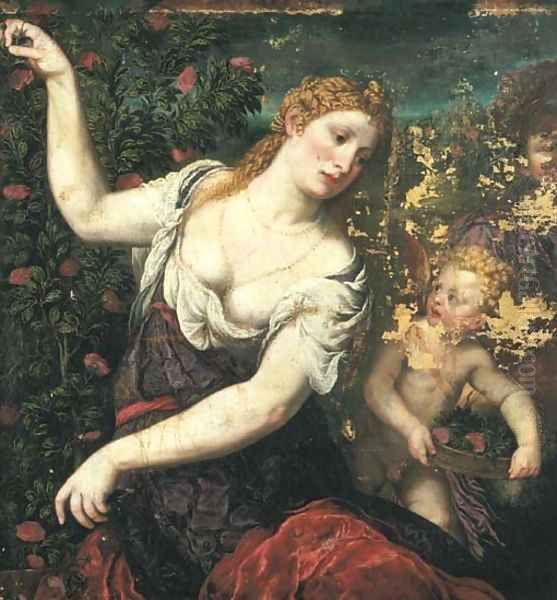
Despite the brevity of his formal training under Titian and their difficult relationship, Titian's influence on Bordone remained profound and undeniable, particularly in his handling of paint, dynamic compositions, and the richness of his palette. However, Bordone did not solely rely on Titian's model. He was also deeply receptive to the lyrical and enigmatic style of Giorgione, whose poetic approach to landscape and mood had captivated Venetian art circles before his early death around 1510. Bordone skillfully absorbed these dual influences, setting the stage for his unique artistic voice.
Forging an Independent Path
Striking out on his own around 1518, Bordone began to build his reputation in Venice and the surrounding territories. His early works demonstrate a conscious effort to synthesize the lessons learned from his predecessors. He combined Titian's robust forms and vibrant color with Giorgione's softer modeling, atmospheric haze (sfumato), and penchant for idyllic or mysterious themes. This fusion resulted in paintings that possessed both Venetian sensuousness and a growing Mannerist sophistication.
Early commissions likely included devotional paintings for private patrons and smaller churches. While the San Niccolò dei Frari commission remains debated, it signifies the ambition Bordone held even at the start of his career. He gradually gained recognition, competing in a crowded field that included established masters like Palma Vecchio and rising stars. His ability to handle diverse subjects – from intimate portraits to large-scale narrative scenes – showcased his versatility.
His style during the 1520s and early 1530s solidified, characterized by increasingly complex compositions, a heightened sense of elegance in figure types, and a distinctive color harmony often featuring warm reds, oranges, and golds balanced by cool blues and greens. He demonstrated a particular talent for rendering luxurious textiles – silks, velvets, and brocades – reflecting the wealth and tastes of his Venetian environment.
The Hallmarks of Bordone's Style
Bordone's artistic signature is defined by several key characteristics that distinguish him within the Venetian tradition. His approach was less about radical innovation and more about a refined and personalized synthesis of existing trends, infused with his own sensibility.
Mastery of Color and Light
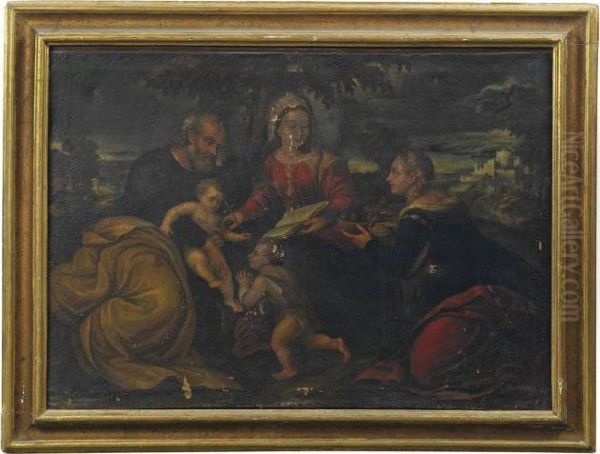
Like his Venetian contemporaries, Bordone was a master of colorito. His palette is often characterized by its warmth, luminosity, and harmonious balance. He favored rich, saturated hues, particularly reds, oranges, and golden yellows, often set against deep blues or greens to create striking contrasts. Unlike the sometimes tumultuous drama of Tintoretto's light or the dazzling pageantry of Veronese's color, Bordone's use of color often feels more controlled, aiming for a luxurious and jewel-like effect. His light is typically soft and diffused, modeling forms gently and contributing to the overall atmospheric quality, reminiscent of Giorgione's legacy but often applied to more complex, multi-figured compositions. In works like The Annunciation, the interplay of light and color creates both divine radiance and palpable texture.
Elegance and the Human Form
Bordone developed a distinctive figural style marked by elegance and grace. His figures, particularly female ones, often possess elongated proportions, slender necks, and delicately featured faces with small, expressive mouths – traits that align with the sophisticated aesthetics of Mannerism developing concurrently in Central Italy under artists like Parmigianino and Bronzino. He excelled at depicting the female form, whether in portraits of noblewomen adorned in sumptuous attire or in mythological scenes featuring idealized nudes. Works like Venus and Cupid or Allegory of Mars, Venus, and Cupid showcase his ability to render flesh tones with a warm, pearlescent glow, combining sensuality with a refined, almost courtly, detachment. His male figures, while robust, often share this same elegance of pose and gesture.
Composition and Narrative
Bordone tackled complex narrative compositions with considerable skill. His large-scale historical and religious paintings often feature numerous figures arranged within elaborate architectural settings or lush landscapes. While influenced by Titian's dynamic arrangements, Bordone's compositions can sometimes feel more densely packed, with figures interacting across multiple planes. He paid meticulous attention to detail, rendering architecture, costumes, and accessories with precision. This careful articulation of setting and detail contributes to the richness of his scenes, although occasionally it can detract from the central narrative focus compared to the more direct storytelling of Titian or the dramatic sweep of Tintoretto. His use of perspective and spatial construction is competent, effectively creating depth and framing the action.
Major Works and Commissions
Bordone's oeuvre encompasses a wide range of subjects and formats, reflecting the diverse demands of his patrons. Several key works stand out as representative of his talent and ambition.
The Doge's Ring: A Venetian Epic
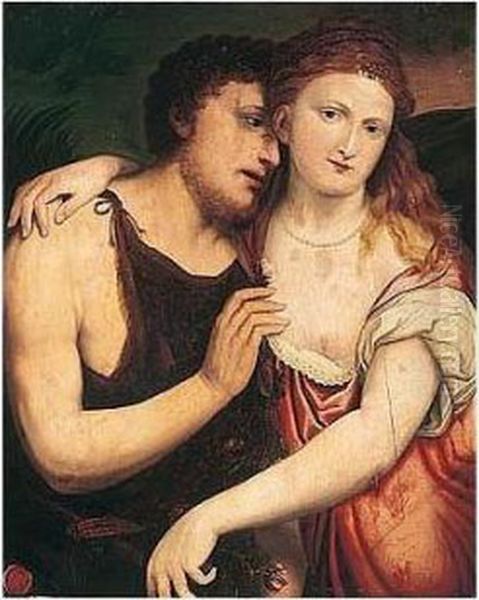
Arguably Bordone's most famous masterpiece is The Presentation of the Ring to the Doge (also known as The Fisherman Consigning the Ring to the Doge), painted around 1534-35 for the Sala dell'Albergo in the Scuola Grande di San Marco in Venice (now housed in the Gallerie dell'Accademia). This large canvas depicts a legendary event where a humble fisherman presents Doge Andrea Gritti with a ring given to him by Saint Mark himself, who had miraculously appeared to save Venice from a demonic storm. The painting is a tour-de-force of Venetian narrative art. Bordone masterfully organizes a crowd of figures within a magnificent architectural setting inspired by Sansovino's Library. The rich colors, detailed rendering of costumes and architecture, and the dramatic lighting create a scene of civic pride and divine intervention, perfectly suited to its institutional setting. It remains one of the quintessential examples of Venetian storia painting.
Religious Devotion
Throughout his career, Bordone produced numerous religious works, including altarpieces and smaller devotional paintings for private contemplation. Examples like the Madonna and Child with Saint Jerome and Saint Francis (Los Angeles County Museum of Art) or the Holy Family with Saint Catherine showcase his ability to infuse traditional religious themes with warmth and humanity. His Madonnas are typically beautiful and serene, his saints noble and expressive. He often placed these figures within atmospheric landscapes or intimate domestic settings, softening the formality sometimes associated with altarpieces. His religious works demonstrate his capacity for both grand public statements and more personal expressions of faith, always rendered with his characteristic richness of color and elegant figural style. He competed in this genre with artists like Lorenzo Lotto, whose works often possessed a more intense psychological depth, and Palma Vecchio, known for his serene Sacre Conversazioni.
Mythological Visions and Allegories
Bordone found a receptive audience, particularly outside Venice, for his mythological and allegorical paintings. These subjects allowed him to explore themes of love, beauty, and power, often featuring sensuous female nudes set within idyllic landscapes. Works such as Allegory with Venus and Cupid (Kunsthistorisches Museum, Vienna), Mars Being Crowned by Victory (Hermitage Museum, St. Petersburg), and Daphnis and Chloe (National Gallery, London) exemplify this aspect of his production. These paintings combine classical erudition with Venetian sensuality, appealing to the sophisticated tastes of courtly patrons. The figures are elegant, the landscapes lush, and the overall mood often one of languid beauty or playful intrigue. This genre provided Bordone ample opportunity to display his skill in rendering flesh tones, luxurious fabrics, and atmospheric effects, aligning him with the broader European taste for Mannerist elegance seen in the works of artists like Giulio Romano.
Portraits of Distinction
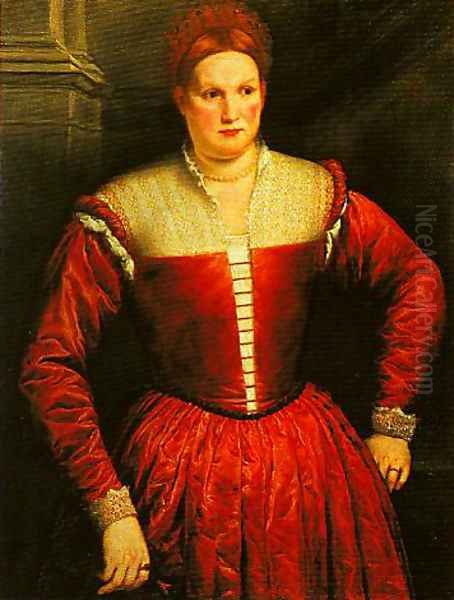
Portraiture was another significant area of Bordone's practice. He was particularly sought after for his depictions of women, capturing both their likeness and the luxuriousness of their attire and status. The Portrait of a Woman in the Pitti Palace, Florence, and the Young Woman at Her Toilette in Vienna are prime examples. These portraits often convey an air of sophisticated allure, sometimes with subtle erotic undertones, achieved through pose, gaze, and the meticulous rendering of details like jewelry and elaborate hairstyles. While perhaps not possessing the profound psychological penetration of Titian's greatest portraits or the stark realism of Giovanni Battista Moroni from nearby Brescia, Bordone's portraits are celebrated for their elegance, vibrant color, and exquisite rendering of texture. He also painted portraits of men, often depicting them with an air of authority and refinement.
A Career Beyond Venice
While Bordone maintained a base in Venice throughout his life, his reputation extended far beyond the lagoon city, leading to important commissions abroad. Unlike some Venetian contemporaries who rarely left the Veneto, Bordone traveled significantly, enhancing his fame and securing patronage from powerful figures across Europe.
The Call to France
One of the most prestigious episodes in Bordone's career was his journey to France, likely around 1538, at the invitation of King Francis I. The French king was a great patron of Italian Renaissance art and had previously employed artists like Leonardo da Vinci and Andrea del Sarto. Bordone worked at the Palace of Fontainebleau, the epicenter of the French Renaissance, alongside Italian artists like Rosso Fiorentino and Francesco Primaticcio who were shaping the distinctive style of the School of Fontainebleau. While specific documented works from this period are scarce, it is believed Bordone painted portraits of the king and members of the court, as well as mythological scenes suited to the palace's decorative schemes. This French sojourn undoubtedly enhanced Bordone's international standing and exposed him directly to the latest currents of Mannerist art outside Italy.
Patronage Across Europe
Bordone's appeal was not limited to France. He also found favor with wealthy patrons in Germany, particularly the powerful Fugger banking family in Augsburg, for whom he executed portraits and possibly other works during visits in the 1540s and 1550s. Evidence also suggests commissions and works finding their way to patrons in Poland and the Netherlands. His style, with its blend of Venetian color, elegant figures, and sophisticated Mannerist elements, seemed particularly well-suited to the tastes of international courts and wealthy merchant elites. This widespread recognition contrasts somewhat with his position in Venice itself, where, despite successes like the Scuola di San Marco commission, he perhaps never quite achieved the same level of consistent high-level patronage enjoyed by Titian or, later, Tintoretto and Veronese. His success abroad underscores the broad appeal of his refined and often decorative style.
Bordone and His Contemporaries
Understanding Paris Bordone requires placing him within the dynamic and competitive artistic environment of 16th-century Venice and beyond. His interactions, influences, and rivalries shaped his career and artistic development.
The Shadow of Titian and Giorgione
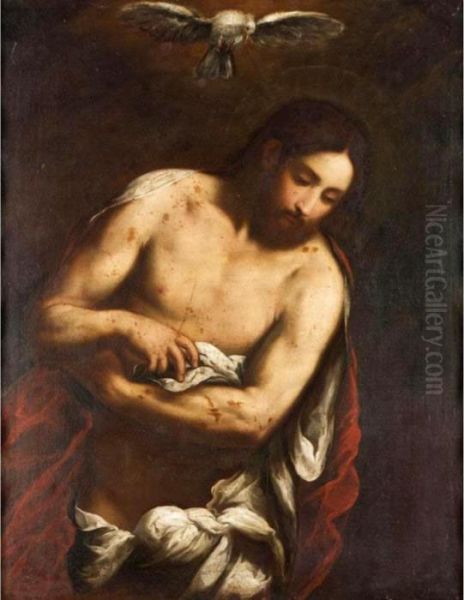
The twin poles of Titian's dynamism and Giorgione's lyricism remained constant reference points throughout Bordone's career. His departure from Titian's workshop set him on an independent course, but the older master's pervasive influence on Venetian painting was inescapable. Bordone continually engaged with Titian's innovations in composition, color, and technique, yet always filtered them through his own sensibility. Similarly, the enduring mystique of Giorgione provided a model for atmospheric landscapes and poetic mood, which Bordone adapted to his more narrative and often more explicitly elegant style. He navigated between these powerful influences, forging a path that acknowledged his debt while asserting his individuality.
Navigating the Venetian Scene
In Venice, Bordone operated alongside a generation of extraordinary talents. Besides Titian, he competed for commissions with Jacopo Tintoretto, whose dramatic energy and rapid brushwork offered a stark contrast to Bordone's more polished finish, and Paolo Veronese, whose grand decorative schemes celebrated the splendor of the Venetian state. He also worked alongside figures like Palma Vecchio in his early years and later Palma Giovane. While Bordone secured important public commissions, he seems not to have dominated the Venetian scene in the way Titian, Tintoretto, or Veronese did at various points. His somewhat tense relationship with Titian might have played a role, or perhaps his style, increasingly infused with Mannerist refinement, resonated less strongly with some local patrons compared to the more robustly Venetian qualities of his rivals. He also interacted with artists like Sebastiano del Piombo, another Venetian who found greater fame outside the city (in Rome). Comparisons are also drawn with contemporaries like Francesco Bonifazio, highlighting shared stylistic tendencies within the broader Veneto region.
Echoes of Mannerism
Bordone's style increasingly incorporated elements associated with Mannerism, the sophisticated and artificial style that emerged in Central Italy and spread throughout Europe. His elongated figures, complex poses, intricate compositions, and emphasis on elegance and grace align him with Mannerist aesthetics. His travels, particularly to France, would have brought him into direct contact with these trends. While firmly rooted in the Venetian tradition of color and light, Bordone represents a Venetian interpretation of Mannerism, distinct from the more intellectually driven or emotionally intense versions seen in Florence or Rome under artists like Bronzino or Parmigianino. His work demonstrates how Venetian art absorbed and adapted broader European stylistic developments.
Later Years and Enduring Legacy
Paris Bordone remained active as a painter into his later years, continuing to produce works for patrons both in Venice and abroad. He died in Venice on January 19, 1571, leaving behind a substantial body of work characterized by its consistent quality and distinctive style.
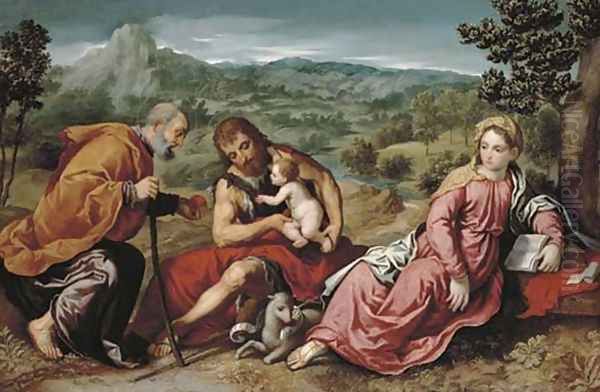
His legacy is somewhat complex. In Venice, he tends to be overshadowed by the towering figures of Titian, Tintoretto, and Veronese. However, his reputation outside Italy, particularly in France and Northern Europe, was considerable during his lifetime and immediately after. His influence can be seen in the works of artists who admired his elegant figures and rich color. Giorgio Vasari included a biography of Bordone in his Lives of the Most Excellent Painters, Sculptors, and Architects, cementing his place in the art historical canon, albeit with the anecdote about Titian perhaps coloring perceptions.
Scholarship on Bordone has faced challenges, partly due to a lack of extensive documentation for many of his works, making precise dating and chronology difficult. Nevertheless, modern art history recognizes him as a highly skilled and important painter who successfully navigated the transition from High Renaissance to Mannerism within the Venetian context. He stands out for his exceptional command of color, his mastery of portraiture (especially female portraits), his significant contributions to mythological painting, and his creation of one of the great Venetian narrative paintings, The Presentation of the Ring to the Doge.
Conclusion
Paris Bordone occupies a unique and significant position in the history of Venetian art. Emerging from the shadow of Titian and deeply influenced by the poetry of Giorgione, he forged a distinctive style characterized by luminous color, refined elegance, and a sophisticated blend of Renaissance naturalism and Mannerist artifice. While perhaps not reaching the absolute pinnacle of fame enjoyed by a select few contemporaries within Venice itself, his talent was widely recognized across Europe, securing him prestigious commissions from royalty and nobility. His works, from grand historical narratives to intimate portraits and sensuous mythologies, continue to captivate viewers with their luxurious beauty and masterful technique. Bordone remains a testament to the richness and diversity of the Venetian School, a master of color and elegance whose contributions significantly enrich the tapestry of Italian Renaissance art.